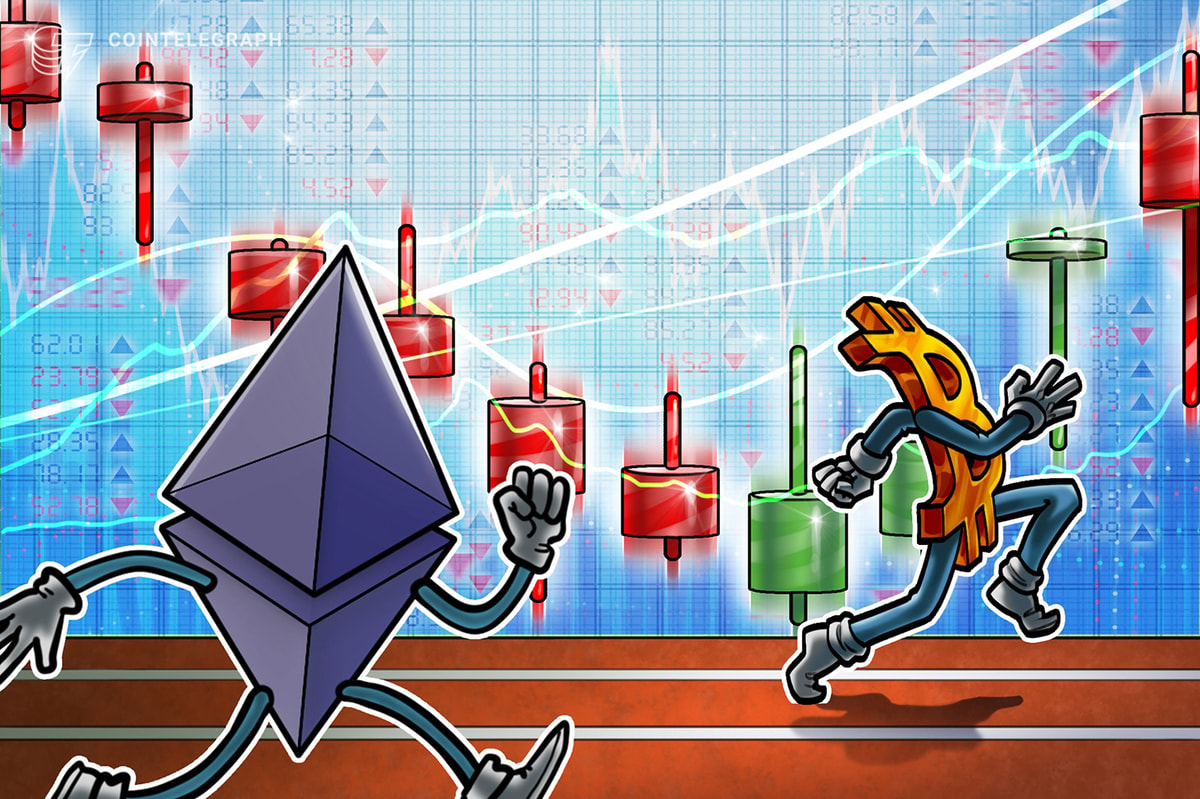The price of Ethereum (ETH) fell 7.3% between October 1 and October 8, wiping out all of the gains of the past two weeks. This decline reflects movements in the broader altcoin market and suggests that the decline is not solely driven by factors within the Ethereum ecosystem. As a result, traders remain uncertain about Ethereum’s ability to get back to the $2,600 level.
Ether/USD (blue) vs. altcoin market cap (magenta). Source: TradingView
Investment sentiment was mixed, with Ethereum falling 2% since September 1, while altcoin market capitalization increased 4.5% during the same period. This discrepancy can be partly attributed to the poor debut of the Ether exchange-traded fund (ETF) in the United States. These ETFs had no net inflows on Oct. 7 and have seen cumulative outflows of $548 million since their launch in July, according to data from Farside Investors.
Ethereum DApps face fierce competition.
Increasing competition from blockchains that prioritize scalability, such as Solana (SOL), BNB Chain (BNB), Tron (TRX), Avalanche (AVAX), and Sui, is further adding to investor frustration. Despite criticism about the risks of centralization, these networks have amassed a combined total value at locked (TVL) of $19.5 billion, equivalent to 43% of Ethereum deposits of $45.6 billion.
Moreover, Ethereum’s dominance in decentralized exchange (DEX) trading volume has fallen significantly from 64% in January 2023 to 22% currently tied with Solana. This trend has raised doubts about Ethereum’s market leadership and has traders worried about potential downward pressure on the Ethereum price.
Weekly DEX trading volume market share. Source: DefiLlama
Ether proponents may argue that Ethereum still holds a leading position when considering layer 2 scaling solutions such as Base, Arbitrum, Polygon, and Optimism. In particular, Base has made significant progress, capturing 14% market share. This is an impressive increase from less than 1% just seven months ago.
Key highlights of the Base network include Aerodrome, which facilitated $2.93 billion in transactions over the past week, and Uniswap, which recorded $1.36 billion in trading volume over the same period. On the Optimism network, Velodrome, a leading decentralized exchange (DEX), recorded trading volume of $360 million, while Arbitrum’s Camelot recorded trading volume of $554 million over the past seven days.
However, Layer 2 networks leverage aggregation technology and take advantage of data storage optimization (BLOB space) introduced in June 2023 to significantly reduce base layer fees. Despite the growth of the Ethereum ecosystem, the number of transactions on the native network remains relatively stagnant. , which partly explains the frustration among Ether investors.
Number of Ethereum transactions, 14-day average. Source: Coin Indicators
The sluggish activity on the Ethereum network has led to undesirable consequences. When competition for processing power is low, Ether becomes inflationary because demand for block space decreases and lower transaction fees reduce the incentive for validators to secure the network.
relevant: Blockchain activity surges 70% in Q3 thanks to AI DApps
BlackRock highlights Ether’s “risk-free” value proposition.
Ethereum’s potential turning point may have come from a surprising source. On October 3, BlackRock, one of the leading providers of Ether ETFs, highlighted that Ether’s value proposition is more aligned with “risky” assets, positioning it as a competitor to stocks and venture capital. According to a post by Bruce Florian, a German Bitcoin user and content creator, this contrasts with Bitcoin’s core narrative of being “digital gold.”
source: Bruceflorian (cropped)
S&P Global Vice Chairman Daniel Yergin told CNBC that the global economy is entering a “perilous period” due to rising tensions in the Middle East and falling oil demand from China. Even more troubling is the fact that mainland China’s CSI 300 stock market index fell 9% on October 8, even as the National Development and Reform Commission announced details of its proposed stimulus plan.
With investors’ appetite for risk decreasing and Ethereum facing fierce competition, it remains unlikely that Ethereum will recover to the $2,600 level, at least in the short term.
This article is written for general information purposes and should not be considered legal or investment advice. The views, thoughts and opinions expressed herein are those of the author alone and do not necessarily reflect or represent the views and opinions of Cointelegraph.

